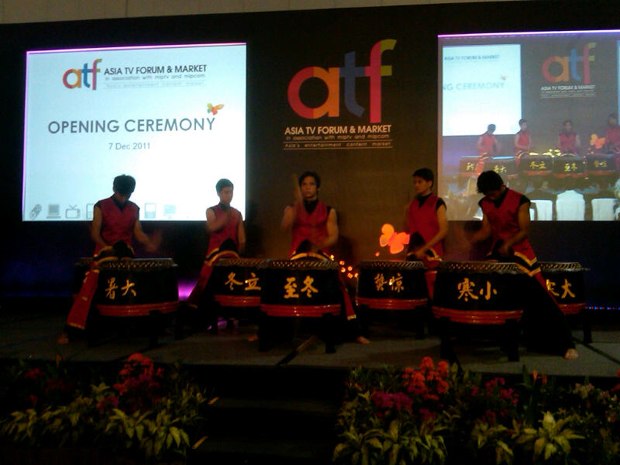If you’re from South East Asia, China, Japan or Korea, Singapore’s modern architectural skylines may not wow you as much as a Westerner. And I imagine, if you are from the region, the proliferation and impact of Asia’s animation production isn’t news to you either. After all, Asia’s “animation moon” has been full and shining brightly for many years, decades even for some countries.
by Catherine Branscome-Morrissey
If you’re from South East Asia, China, Japan or Korea, Singapore’s modern architectural skylines may not wow you as much as a Westerner. And I imagine, if you are from the region, the proliferation and impact of Asia’s animation production isn’t news to you either. After all, Asia’s “animation moon” has been full and shining brightly for many years, decades even for some countries.
Yet, in some of the traditional hot spots of animation, government funding has started to wane in recent years. Today, seasoned cartoon vets from Korea and Japan reflect on their “good old days,” and due to their mature businesses, they’ve become the best advisors for their geographic neighbors to learn the ropes of growth and studio survival. Work-for-hire deals at younger Asian studios are still important, but for many, it's not the focus. Admittedly, steady work does keep the studios active and “on the ready” to work on their studio bosses' true ambitions: original I.P. creation and coproduction partnerships.
Wisely, Singapore’s Reed Exhibitions team (organizers of ATF since inception) programmed events during the market such as the Asian Animation Showcase, which take place simultaneously with the buying and selling meetings on the other side of the modular walls. Emerging animation producers, who were able to slip away from the market hubbub and attend the Showcase, heard country-specific insights and future market trends from seasoned executives: Korea’s SamG Animation Co., China’s Toonmax Media, Malaysia’s Animasia Studio, Singapore’s Sparky Animation and Taiwan’s Xanthus Digital Picture.
At ATF’s Conference Theatre, SamG’s Harry Yoon presented a terrific large screen PowerPoint, jammed with valuable details. Harry made it clear, he means business, and he “gets” the business too, including sharing tidbits like “16 out of 30 points are needed to trigger Korean [government] funding” and “Korean channels pay more if you get the certificate” and the bad news “Korean broadcasters don’t pre-buy.”
Movers and shakers in Asian animation are as astute (and in the same boat) as North American, European and Australian I.P. creators, who realize that budgets are tougher to raise, lower costs a must, and government support crucial for survival. Yet, be careful warns Harry “coproduction is a marriage” - you have to get to know each other first, understand each other(s) culture… and know when to compromise! [if not, if you don’t shut up sometimes, you may have to leave and that means divorce!]
What surprised me about Asian animation industry is that there are so many interesting regional combos happening, like Korea-Malaysia, Japan-Singapore and even Malaysia-Thailand. Sometimes with “G-to-G support” (translation: Government to Government), these regional alliances can eliminate a studio’s need to involve yet another third partner, from a budgetary point of view. Yet the most clever and sharpest studios, whether “old” or “young,” realize that merely coming up with a budget that can be funded regionally, doesn’t guarantee that you’re making global content.
The bottom line in Asia is the same as anywhere else in the world: the best projects need marketplace feedback and producers need help to shape their shows for their home territory broadcaster or for a regional cable channel. On a practical level, Asian studios also need television’s financial input, not just creative feedback. Thus, nothing’s “new under the sun,” the fundamentals apply around the world: program/series concept, designs and writing need to be tested early on for [their] likeability factors and cross-border acceptance.
Overwhelmingly after interviewing a vast array of regional animation studios during the ATF, one bell rang the loudest. THE WRITING. Nothing replaces good solid storytelling, and everyone seems aware of this simple entertainment truth. Thus, in group presentations, and in individual one-on-one meetings during the three-day ATF, I zeroed in on this topic, as the range and scope of 2D, CG and true 3D animation technologies and fantastic execution seemed, wasn’t nearly as interesting as finding out how these studios approach “the telling of” their original stories.
ATF INTERVIEW and SESSION HIGHLIGHTS (by country)ChinaFANTAWILD ANIMATION INC. Lilly Li, Sales. On scripts for multiple Fantawild CGI series, 100% China financing. “Only one [of our many] series wasn’t written entirely by Chinese writers. The Director and Writer of ONE AND A HALF HEROES, is American - but he works for us, on staff.”
TOONMAX ANIMATION. Yu Jie, Deputy General Manager. “We want to make joint efforts… to create our own animation brands.”
KoreaPIXTREND. Do-Young Yim, General Manager. On animation series writing - “Koreans were not previously as good as Western writers, but now Koreans are getting good. Original scripts and story synopses are coming from Korea. Still, we always have Story Editors, from either the U.S., U.K. or Canada.”
SUNWOO. Moon-Ju Kang, Managing Director. On coproduction and writing - “We partnered with a French company on Season 1 and now for Season 2, we’ve developed and produced it 100% ourselves, still using Korean writers, who worked with an American story editor from LA on both Season 1 and 2.”
MalaysiaANIMASIA. Edmund Chan, Managing Director. “We’re at the early stage of a new series, based on an old myth that we’re modernizing. Right now our [coproduction] partner is applying for a Chinese government approval and funding. Our writers will be US or UK writers, plus two Chinese writers. We also have a possible French partner on this one, he liked the art design.”
AVANT GUARDE. Syed Hezri, Managing Director. “We already have 10 episodes of 52x11 done, all scripts were done in-house, but we did hire a New York script editor who is helping on our original series NINJA CAT.”
INSPEDIA. C.J. See, Sales and Marketing Director. On coproducing - “Sometimes we work here directly with the channel, and a lot of times we’re coproducing.” “We’re mostly comedy-driven, very slapstick.”
INTELTURE TECHNOLOGY. “Jin” Ng Jin Chong, Director. On scripts and pre-production for 3D half-hour series MASK MASTER, coproduction with Korean partner Studio Baba - “We have to trust them in the story, as our coproduction partner. Otherwise, [the scripting] could be a never-ending story.”
MULTIMEDIA DEVELOPMENT CORPORATION (MDEC). Regis Brown, Senior International Representative. On Malaysia as a prospective animation partner -“MDEC [the government] has programs that offer attractive subsidies and customized incentives for outside companies interested in doing business in Malaysia… Not only are original Malaysian productions being supported, in so many ways [MDEC and other government bodies] are supporting the entire Malaysian animation and entertainment industry as a whole.”
SingaporeSPARKY ANIMATION. KC Wong, Founder & CEO. On scripts and coproduction of the Japanese literary property ONE STORMY NIGHT, which sold over 1 million books to date. “We’re going to produce [our animated 3D half-hour series] in English first, then adapt to Japanese, even thought we have the original Japanese writer [writing the episode scripts]. We believe the story can cross borders, it delivers a wonderful basic message about friendship, catches any kid's mind across the world.” KC added, “Japan’s coming to a turning point, even though they are the second largest market after the US for entertainment, their [audience] base of kids, is shrinking.”
TINY ISLAND. David Kwok, CEO. On scripts for 3D half-hour series DREAM DEFENDERS. “We’ve hired a team of 15 writers from LA, through Monteiro Rose Dravis Agency Inc. Our [original I.P.] is like the movie Inception, for kids. The tables are turning around, we have tons of opportunities, we have partners across Asia and right now we’re also doing a work-for-hire for Cartoon Network, a 3D Ben 10 movie for their channels.”
**********************
There’s hardly room (or time) to cover all the interesting Asian animation partnerships emerging: so many inter-Asian via official co-productions, so many encouraged and supported by government agencies and subsidy/incentive programs. Other inter-regional collaborations are happening due to a pure common sense business reason: these days it’s cheaper to sub-contract and have the main production work done in South-East Asia, where the cost of labor is cheaper in the South than it is in the north of Asia.
Coproducing with Western animation companies is also unanimously viewed by the region as a plus, with the credits implying subsidy countries are the favorites, where government financing helps everybody meet the total production costs.
However, placing strategic financing partnerships to the side, THE most common element that the region’s animation studios endorse: nearly all of them hire Story Editors for the West. So if you fit the Story Editor profile, your next meal ticket may not be a major studio series, your home run is more likely to originate for you in Asia!
Dan Sarto is Publisher and Editor-in-Chief of Animation World Network.











